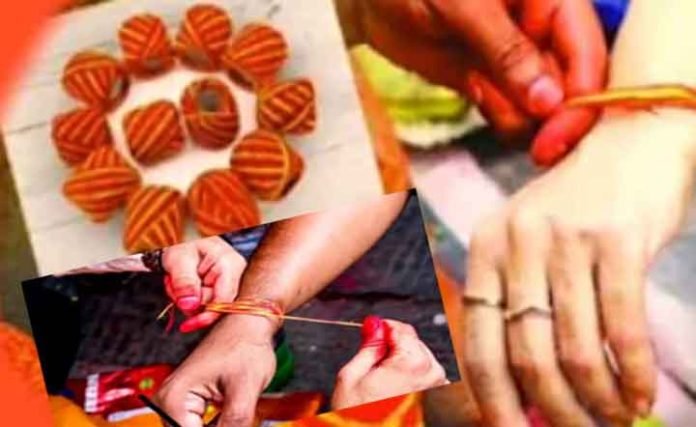The Tradition of Raksha Sutra in Sanatan Dharma : The Raksha Sutra, also known as Kalava, holds a special place in Sanatan Dharma, symbolizing auspiciousness and divine grace. This sacred thread, typically red and yellow, is revered for its spiritual significance and protective qualities. Despite its prominence, many people lack comprehensive knowledge about the proper rituals and timings associated with Raksha Sutra. In this article, we delve into the detailed guidelines for tying, wearing, and removing the Raksha Sutra, ensuring you can fully benefit from this holy practice.
On Which Hand Should Girls and Women Tie Raksha Sutra?
Astrological guidelines specify different rules for tying the Raksha Sutra based on gender and marital status. For unmarried girls, it is deemed auspicious to tie the Raksha Sutra on the right hand. Conversely, married women should tie it on the left hand. This distinction is rooted in ancient traditions that align the practice with the individual’s life stage and spiritual needs. For men, the Raksha Sutra should always be tied on the right hand.
The Right Way to Tie Raksha Sutra
The process of tying the Raksha Sutra is not merely a ritual but a deeply symbolic act that requires adherence to specific guidelines mentioned in religious scriptures. Here is the correct method:
- Prepare Your Hand: Hold a coin or a rupee in the hand where the Raksha Sutra will be tied and make a fist.
- Symbolic Gesture: Place your other hand on your head, signifying humility and readiness to receive divine protection.
- Wrapping the Thread: Have the Raksha Sutra wrapped around your wrist three, five, or seven times. These numbers hold spiritual significance, often representing completeness and protection.
- Offering Dakshina: After tying the Raksha Sutra, offer the coin or rupee as Dakshina to the person who tied the thread, symbolizing gratitude and respect.
On Which Day Should the Raksha Sutra Be Removed?
According to scriptures, the Raksha Sutra should be removed only on Tuesday or Saturday. These days are considered auspicious for concluding the protection offered by the Raksha Sutra. When removing it, follow these steps to ensure continued blessings:
- Renewal: Immediately tie a new Raksha Sutra while sitting in the puja room of your house. This act symbolizes a continuous cycle of protection and divine grace.
- Proper Disposal: Never discard the old Raksha Sutra carelessly. Instead, float it in a holy river or flowing water, or place it under a Peepal tree. This respectful disposal prevents inauspicious outcomes and maintains the sanctity of the ritual.
Significance of the Raksha Sutra
The Raksha Sutra is more than a mere thread; it is a conduit of divine blessings and protection. Tying it involves invoking the grace of deities and seeking their protection against negative influences. Here are some key reasons why this tradition is vital:
- Protection: The Raksha Sutra is believed to guard against evil forces and negative energies, ensuring the wearer’s safety and well-being.
- Auspiciousness: The colors red and yellow symbolize purity, strength, and divine energy, bringing auspiciousness to the wearer’s life.
- Spiritual Connection: By following the rituals associated with the Raksha Sutra, individuals strengthen their spiritual connection and align themselves with divine will.
Different Rules for Girls Before and After Marriage
Astrological traditions prescribe different practices for tying the Raksha Sutra before and after marriage, especially for girls and women. This distinction ensures that the protective and auspicious qualities of the Raksha Sutra are aligned with their evolving spiritual needs.
Before Marriage
- Right Hand: Unmarried girls should tie the Raksha Sutra on their right hand, which is considered to attract positive energies and safeguard their prospects.
After Marriage
- Left Hand: Married women tie the Raksha Sutra on their left hand, symbolizing the nurturing aspect of their role and the protection of their marital harmony.
The Raksha Sutra is a profound symbol of faith and protection in Sanatan Dharma. By understanding and adhering to the correct practices for tying, wearing, and removing this sacred thread, one can maximize its spiritual benefits. Whether you are an unmarried girl, a married woman, or a man, following these guidelines ensures that you remain under the divine protection and grace that the Raksha Sutra bestows.
Embrace this ancient tradition with reverence and awareness, and let the Raksha Sutra guide you towards a life filled with auspiciousness and spiritual protection.
















